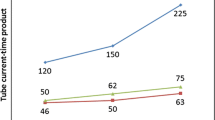Abstract
Background
CT examinations of the head and neck are the most commonly performed CT studies in children, raising concern about radiation dose and their risks to children.
Objective
The purpose of this study was to clarify radiation dose levels for children of 6 years of age undergoing head and neck multidetector CT (MDCT) examinations.
Materials and methods
Radiation doses were measured with small-sized silicon-photodiode dosimeters that were implanted at various tissue and organ positions within a standard 6-year-old anthropomorphic phantom. Organ and effective doses of brain CT were evaluated for 19 protocols in nine hospitals on various (2–320 detector rows) MDCT scanners.
Results
The maximum value of mean organ dose in brain CT was 34.3 mGy for brain. Maximum values of mean doses for the radiosensitive lens and thyroid were 32.7 mGy for lens in brain CT and 17.2 mGy for thyroid in neck CT. seventy-fifth percentile of effective dose distribution in brain CT was approximately the same as the diagnostic reference level (DRL) in the 2003 UK survey.
Conclusion
The results of this study would encourage revision of MDCT protocols in pediatric head and neck CT examinations for dose reduction and protocol standardization.


Similar content being viewed by others
References
Brenner DJ, Elliston CD, Hall EJ et al (2001) Estimated risks of radiation-induced fatal cancer from pediatric CT. AJR 176:289–296
Kawaura C, Aoyama T, Koyama S et al (2006) Organ and effective dose evaluation in diagnostic radiology based on in-phantom dose measurements with novel photodiode-dosemeters. Radiat Prot Dosimetry 118:421–430
McLean D, Malitz N, Lewis S (2003) Survey of effective dose levels from typical pediatric CT protocols. Australas Radiol 47:135–142
Pages J, Buls N, Osteaux M (2003) CT doses in children: multicentre study. Br J Radiol 76:803–811
Miyazaki O, Kitamura M, Masaki H et al (2005) Current practice of pediatric MDCT in Japan: survey results of demographics and age-based dose reduction. Nippon Igaku Hoshasen Gakkai Zasshi 65:216–223
Galanski M, Nagel HD, Stamm G (2007) Paediatric CT exposure practice in the federal republic of Germany: results of a nationwide survey in 2005–2006. Available at http://www.mh-hannover.de/fileadmin/kliniken/diagnostische_radiologie/download/Report_German_Paed-CT-Survey_2005_06.pdf. Accessed 14 Sep 2009
Arch ME, Frush DP (2008) Pediatric body MDCT: a 5-year follow-up survey of scanning parameters used by pediatric radiologists. AJR 191:611–617
Verdun FR, Gutierrez D, Vader JP et al (2008) CT radiation dose in children: a survey to establish age-based diagnostic reference levels in Switzerland. Eur Radiol 18:1980–1986
Brisse HJ, Aubert B (2009) CT exposure from pediatric MDCT: results from the 2007–2008 SFIPP/ISRN survey. J Radiol 90:207–215
Munk RD, Strohm PC, Saueressig U et al (2009) Effective dose estimation in whole-body multislice CT in paediatric trauma patients. Pediatr Radiol 39:245–252
Nishizawa K, Matsumoto M, Iwai K et al (2004) Survey of CT practice in Japan and collective effective dose estimation. Nippon Igaku Hoshasen Gakkai Zasshi 64:151–158
Ghotbi N, Ohtsuru A, Ogawa Y et al (2006) Pediatric CT scan usage in Japan: results of a hospital survey. Radiat Med 24:560–567
ICRP (1991) ICRP Publication 60: the 1990 Recommendations of the International Commission on Radiological Protection. Elsevier Science, Oxford
ICRP (2007) ICRP Publication 103: The 2007 Recommendations of the International Commission on Radiological Protection, Annals of the ICRP 37(2-3). Elsevier Science, Oxford
Hiraoka T (1999) The basic data of materials for human body phantom. Iyou Hyoujun Senryou 4:23–28
Fujii K, Aoyama T, Koyama S et al (2007) Comparative evaluation of organ and effective doses for paediatric patients with those for adults in chest and abdominal CT examinations. Br J Radiol 80:657–667
ImPACT-CT patient dosimetry calculator version 1.0. (2009) http://www.impactscan.org. St George’s Hospital, London, UK. Accessed 14 Sep 2009
Shrimpton PC, Hillier MC, Lewis MA et al (2006) National survey of doses from CT in the UK: 2003. Br J Radiol 79:968–980
Brenner DJ (2002) Estimating cancer risks from pediatric CT: going from the qualitative to the quantitative. Pediatr Radiol 32:228–231
Fearon T, Vucich J (1987) Normalized pediatric organ-absorbed doses from CT examinations. AJR 148:171–174
Mazonakis M, Tzedakis A, Damilakis J et al (2007) Thyroid dose from common head and neck CT examinations in children: is there an excess risk for thyroid cancer induction? Eur Radiol 17:1352–1357
Tack D, Gevenois PA (eds) (2007) Radiation dose from adult and pediatric multidetector computed tomography. Springer, Berlin
Fujii K, Aoyama T, Yamauchi-Kawaura C et al (2009) Radiation dose evaluation in 64-slice CT examinations with adult and pediatric anthropomorphic phantoms. Br J Radiol 82:1010–1018
Nishizawa K, Mori S, Ohno M et al (2008) Patient dose estimation for multi-detector-row CT examinations. Radiat Prot Dosimetry 128:98–105
Chapple CL, Willis S, Frame J (2002) Effective dose in paediatric computed tomography. Phys Med Biol 47:107–115
Shrimpton PC, Hillier MC, Lewis MA et al (2005) Doses from computed tomography (CT) examination in UK-2003 review. Report NRPB-W67. NRPB Publication at http://www.hpa.org.uk/web/HPAwebFile/HPAweb_C/1194947420292. Accessed 14 Sep 2009
Thomas KE, Wang B (2008) Age-specific effective doses for pediatric MSCT examinations at a large children’s hospital using DLP conversion coefficients: a simple estimation method. Pediatr Radiol 38:645–656
ICRP (1997) ICRP Publication 73: radiological protection and safety in medicine. Annals of the ICRP 261. Elsevier, Oxford
Huda W, Lieberman KA, Chang J et al (2004) Patient size and x-ray technique factors in head computed tomography examinations. I. Radiation doses. Med Phys 31:588–594
Acknowledgement
This study was supported in part by a Grant-In-Aid for Scientific Research (No. 18510043) from the Ministry of Education, Culture, Sports, Science and Technology of Japan.
Author information
Authors and Affiliations
Corresponding author
Rights and permissions
About this article
Cite this article
Yamauchi-Kawaura, C., Fujii, K., Aoyama, T. et al. Radiation dose evaluation in head and neck MDCT examinations with a 6-year-old child anthropomorphic phantom. Pediatr Radiol 40, 1206–1214 (2010). https://doi.org/10.1007/s00247-009-1495-z
Received:
Revised:
Accepted:
Published:
Issue Date:
DOI: https://doi.org/10.1007/s00247-009-1495-z




